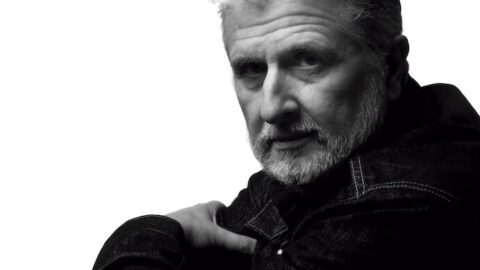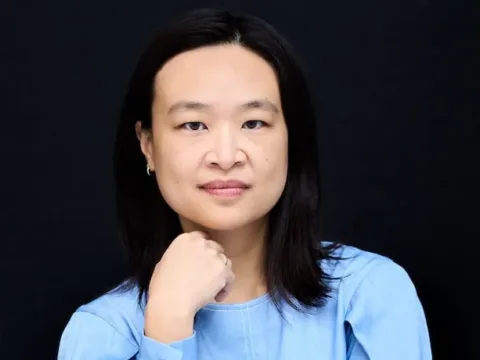This article was commissioned by American Composers Forum.
José Halac is seemingly full of contradictions. He finds inspiration in both nature and highly-structured systems, like geometry and mechanics. He craves the complete creative control of electronic composition, but thrives on collaboration with other artists. He wants his works to be known, but he himself wants to be no one — a nondescript face in the crowd. Yet somehow, in speaking with the 61-year-old Argentinian composer, these dichotomies begin to feel symbiotic; they exist not in opposition, but in harmony.
Halac is an innova Recordings artist and American Composers Forum awardee living in Córdoba, Argentina. He joined our Zoom call from his home studio, and behind him sat a piano — his mother’s piano — which holds his earliest musical memories. Though his mother, a trained concert pianist, had stopped performing after having children, her interpretations of the late-Romantic warhorses regularly filled the Halac home. His father, meanwhile, was a businessman who loved tango and saw his son as a “monkey” who could perform for his friends and family. Halac was a shy, bullied kid who loved escaping into the world of TV, but he quickly took to music when his father bought him a small guitar. With help from his music teacher, Halac learned to sing Argentinian folk songs and tango, and eventually began picking up songs from TV and the radio by ear.
Though music was an integral part of Halac’s childhood, he initially went to college to study biochemistry, at his father’s suggestion. When he dropped out of the program, his mother intervened and encouraged him to enroll in music school to study composition. During those years, he visited New York City with his family and immediately knew he was going to live there one day. When he finally moved to Brooklyn in 1989, after completing his composition degree, he found tremendous personal and artistic freedom in being anonymous amid the bustling city.

Living in New York allowed Halac to soak up his surroundings while remaining fluid, malleable, and unrestrained by labels or categories. “Being on the subway and not being recognized by anyone at any time — being no one is wonderful,” he told me. “In New York, you can be a zero and it’s perfect. That relieves me… I don’t like to ‘fit.’ I need to slide away from things, and I cannot be loyal to whatever you’re expecting from me, especially in music. So, I betray people a lot in that sense: I’m a loyal human being, but not a loyal artist.”
Rodolfo Imas, an architect and a friend, helped Halac understand the paradox that made New York feel so liberating. “Rodolfo told me that New York is a ‘site,’ an empty place where you can build something, but if anything, New York is already built,” Halac explained. “You cannot see emptiness there — so how do you see that as a void?” But this combination of dense activity and endless possibility gave Halac experimental carte blanche. “That’s the thing about New York. I don’t think it happens anywhere else; it has a way of letting you in and making you feel that you can do whatever you want — that it’s an empty place.”
Halac had been creating this void-like environment for himself since childhood. When he was very young, his mother would tuck him tight into his bed at night. Once the lights were out, he would crawl under the covers and spin around until he had no sense of direction and the boundaries of the room ceased to exist. As an adult, Halac’s best compositional ideas arise from those limitless empty spaces — with no rigid parameters or historical precedents, he is free to explore without getting boxed into a particular narrative.
During his 15 years in New York, Halac received crucial support from American Composers Forum and its label, innova Recordings, that helped define his “syncretic” approach to music creation — a meticulous layering of mediums and cultural influences, including poetry, improvisation, sampling, folk music of northwest Argentina, and electronics.
His first major syncretic composition, La Quebrada del Grito (The Breaking of the Scream, 1999), is an acousmatic work — specifically designed for speaker playback rather than live performance. To create the piece, Halac ran a traditional Quechua chant through his computer, then deconstructed the source material and remixed it with spoken word and his own recorded scream. The visceral 10-minute work ricochets, phases, and shimmers through tidal waves of sound, unified by the electronic abstraction of Halac’s voice.
Shortly after La Quebrada del Grito was completed, it was selected for innova Recordings’ Sonic Circuits series, a traveling festival of electronic music with unique permutations in different cities. Being included on Sonic Circuits VII provided “so much encouragement and affirmation that maybe I was on the right track,” Halac said. This gave him the confidence to submit the work to other festivals and opportunities – and it won first prize at the 2000 Bourges International Festival of Electroacoustic Music and a New York Foundation for the Arts (NYFA) award.
Years later, the NYFA award created the opportunity for Halac’s work to be featured on another innova anthology album: The NYFA Collection – 25 years of New York New Music (2010). Nestled between music by Pauline Oliveros, Lukas Ligeti, Meredith Monk, and Wadada Leo Smith is Halac’s BLOWN 2. The textural, acousmatic piece manipulates sounds recorded by Argentinian bass clarinetist Nicolás Maza, including resonant, percussive key clicks, faint interjections of deep, reedy tones, and labored breathing that is amplified through the body of the instrument.
For Halac, acousmatic composition has a certain “seduction,” particularly in the process of sampling and then removing live performers. Producing an electronic work that sounds exactly the same with every playback gives him total control over the “projections and ghosts” that come out of the speakers. “I’ve seen structures in my brain all my life. When I write music, I don’t see colors, but I see shapes, and I need it to be fulfilled somehow. Electronics are very easy; they do exactly what you need. But humans — I’m talking like I’m from outer space — human beings are very imperfect and very subtle in their imperfections.”
Blending the best of human performers and electronics has resulted in a rich catalog of electroacoustic compositions, including Rooms — a timbrally prismatic work written for Argentinian pianist Adriana de los Santos and supported by an ACF JFund award (now ACF | create). The premiere in Buenos Aires brought significant attention to Halac’s work and directly led to future commissions, including Nocaut Técnico (2003), a dance music piece for the prestigious Teatro Colón.
Halac now teaches composition at the Universidad Nacional de Córdoba in Argentina, but still travels to the U.S. occasionally. Last fall, he visited the University of Missouri for a residency at Mizzou New Music Initiative, which included the premiere of Fragile Pulsings of Tectonic Folds. With electronics notably missing, the angular, technically demanding chamber ensemble piece exemplifies his current approach to composition, which is becoming more architectural. Whereas the structural and emotional framework of his early syncretic pieces had come from folk songs, now he finds that he can generate the form and emotions himself. “I used to deconstruct. Now I construct,” he explained. “It took me 20 years or more, but I got there.”
The discipline that Halac has cultivated in his compositional process now sheds light on the reason his mother never taught him the piano: with her rigorous Russian training, it was all or nothing. “I can say that as a composer, I now have the training she had as a pianist,” Halac reflected. “I’m equal to her, but it took me many, many years of sacrifice and study. But I understood the level — that’s something that she gave me. When you are with someone like that, you know the level from birth. So, I can now say I have that. I have that and I’m happy.”
I CARE IF YOU LISTEN is an editorially-independent program of the American Composers Forum, and is made possible thanks to generous donor and institutional support. Opinions expressed are solely those of the author and may not represent the views of ICIYL or ACF.
You can support the work of ICIYL with a tax-deductible gift to ACF. For more on ACF, visit the “At ACF” section or composersforum.org.
























